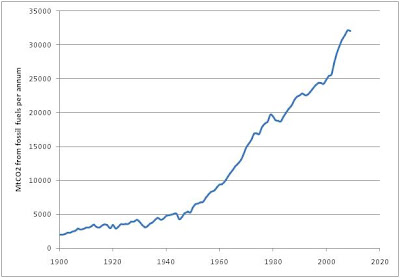I recently had a piece in Anthony Watt's Watts Up With That blog. It attracted a few hundred comments, which was gratifying. It was written in ordinary language, so used some inexactitudes because I felt that communication was more important, in this case, than precision. Some suggested it should be republished elsewhere - so this is the first part of a long story.
The world has
been getting slightly warmer. Of that
there is little doubt. The measurements
by which we know that it is warming are poor.
The figures are not accessible, and keep on changing[i]. Many points at which temperature is measured
are badly sited, and bound to give misleading results[ii]. Nevertheless, almost everyone agrees that the
world is warmer today than it was 150 years ago.
There are
some fairly clear signals of a warmer world.
The Arctic ice is less than it was[iii].
Many glaciers are retreating[iv]. Some glaciers – for instance, those on
Kilimanjaro – are shrinking because the long-term precipitation is less than it
was 150 years ago, not because it is warmer[v].
Others seem to be shrinking from a warmer climate. There are, however, little
data on this[vi].
Where the
sceptic differs from many other scientists is in ascribing the warming to human
activities – specifically, the burning of fossil fuels and the concomitant rise
in the carbon dioxide concentration in the atmosphere. The hypothesis is that the carbon dioxide traps
infra-red radiation that would otherwise escape to space. This means that some of the energy received
from the sun is not lost, and the trapped energy leads to a warming of the
globe.
The physics
of how carbon dioxide traps infra-red radiation is well known[vii]. But there are other molecules in the
atmosphere that also trap infra-red radiation.
Water vapour is the predominant “greenhouse gas”[viii].
What is not so clear is the extent to which the trapping of energy causes heating. There are wonderful mathematical models that
claim to show how heating occurs.
Unfortunately, all the models suffer from identifiable flaws, a point considered
later.
A prime difficulty
with the anthropogenic warming thesis is that it is not known how much of the
warming is natural and how much might be caused by carbon dioxide. It is simple to illustrate this. Figure 1
shows the global temperature record as kept by the Climate Research Unit at the
University of East Anglia[ix].
 |
| Figure 1 Global temperatures, relative to 1950-1990 average |
The global
temperature dropped from 1850 to 1860; rose until 1880; dropped until 1910;
rose until 1945; dropped until 1980; rose until 2000; and has dropped slightly
since then.
Figure 2
shows the carbon dioxide record. Careful measurements have been made at Mauna
Loa on Hawaii since 1958[x]. The pre-industrial level of CO2 in
the atmosphere is generally accepted to have been about 280ppm[xi].
Figure 2 shows a reasonable extrapolation of the data back to about 280ppm in
1800.
 |
| Figure 2 Atmospheric CO2 concentrations, measured and estimated. |
It is a
reasonable assumption that the measured rise is the result of fossil fuel
consumption. Figure 3 shows annual CO2
emissions over time[xii]. It only exceeded 5 billion tons per annum in
the later 1940’s. Thereafter it grew
rapidly, passing 10 billion tons in 1963, 15 billion in 1971, 20 billion in
1986 and 30 billion in 2006.
 |
| Figure 3 Annual CO2 emissions from fossil fuel consumption. |
If most of
the temperature changes before 1945 were largely natural, then there is great
difficulty in determining how much of the temperature change after 1945 is
natural and how much might be driven by increasing carbon dioxide. This raises the question of what the natural
variation in temperature might be.
To answer
this question, consider the Vostok ice core record over the past 9000 years[xiii]. The core was sampled every metre of depth,
which represented ~20 years of accumulation in the upper layers and ~50 years
in the lower levels. The temperature was
estimated from differences in the oxygen isotope ratios. While a point measurement such as this cannot
give a good measure of the average global temperature, it is a reasonable
measure of changes in global
temperature, and it is primarily temperature changes that are of interest.
The data
are shown in Figure 4. There has been a slight cooling over the past 9
millennia, as shown by the least-squares line.
The data were therefore detrended before further analysis – the mean
temperature at any one date was added to the reported relative temperature. The detrended temperatures were what is known
as “normally distributed”, i.e. there was nothing abnormal or skewed about them.
Then the rate of change between each detrended temperature and the temperature
approximately 100±20 years earlier was calculated and expressed as a rate per
century. The results were also normally
distributed, with a standard deviation of 0.94oC per century.
 |
| Figure 4. Relative temperatures over the past 9000 years. |
Thus there
is about a 2:1 chance that the temperature may vary by up to 1oC per
century from natural causes, but only about a 1 in 10 chance that it will vary
by more than 1.9oC naturally. Between 1900 and 2000, it varied by
about 0.9oC, which is therefore within the range of natural
variation.
And that, in simple terms, is
why there is scepticism about the thesis that carbon dioxide is causing global
warming – there is no clear signal of any such warming effect.
[iv] Paul,
F., Kääb, A. and Haeberli, W. Recent glacier changes in the Alps observed by
satellite: Consequences for future monitoring strategies, Global and Planetary
Change, Volume 56, Issues 1–2, March 2007, Pages 111-122, ISSN 0921-8181,
10.1016/j.gloplacha.2006.07.007.
(http://www.sciencedirect.com/science/article/pii/S0921818106001603)
Accessed January 2013
[v] Mölg,
T., and D. R. Hardy (2004), Ablation and associated energy
balance of a horizontal glacier surface on Kilimanjaro, J. Geophys. Res.,
109, D16104, doi:10.1029/2003JD004338.
[vi] UNEP Global glacier changes: facts
and figures. World Glacier Monitoring Service, 2008
[vii] http://scienceofdoom.com/roadmap/atmospheric-radiation-and-the-greenhouse-effect/
Accessed January 2013


No comments:
Post a Comment